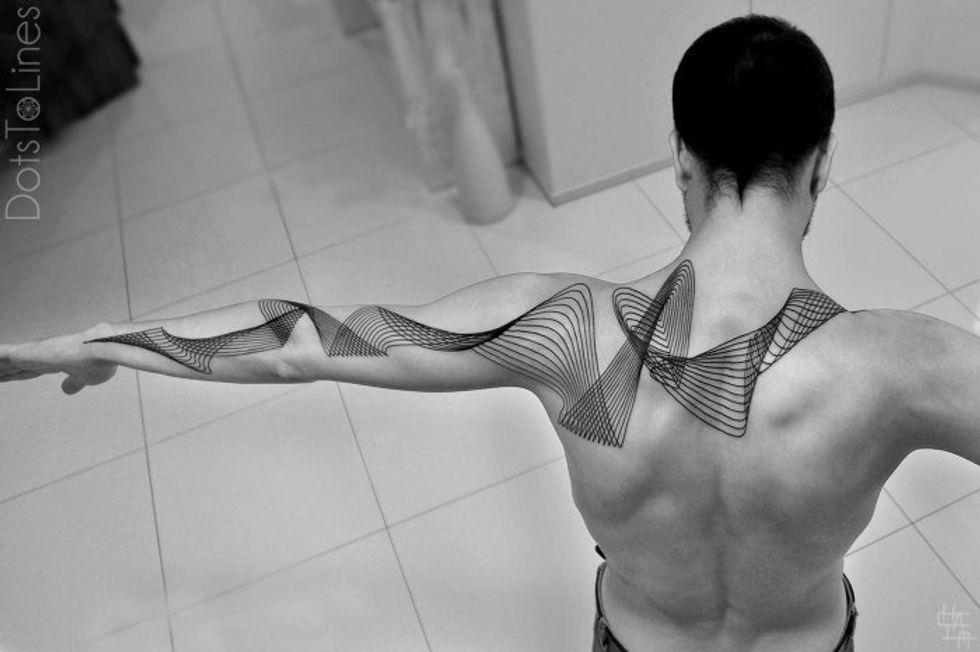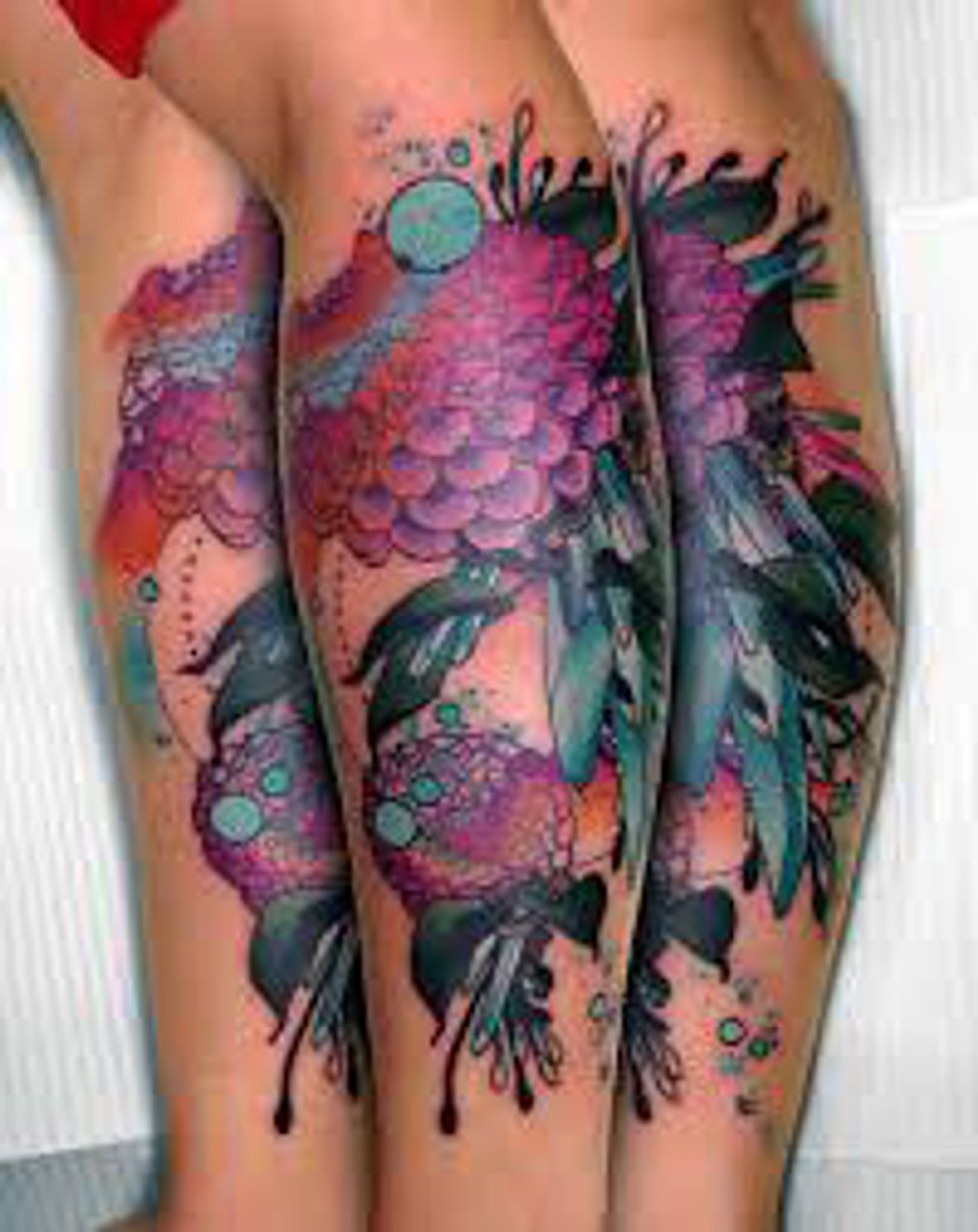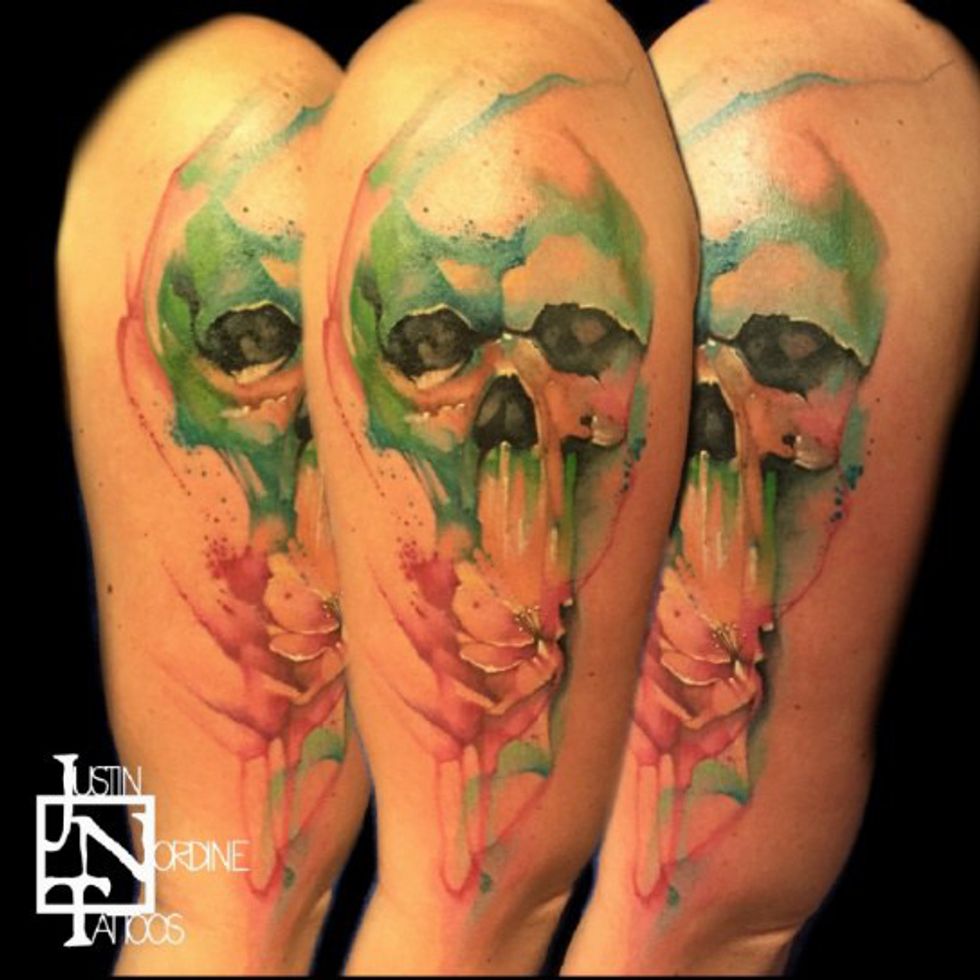The first tattoos were probably created by mistake. Someone had a small scratch and rubbed ashes in it and after the wound healed, the mark remained. In its simplest form, tattooing is the process of inserting colored materials beneath the skin's surface. In it's most modern form, tattooing is an artistic endeavor that requires a dedicated individual and an artist who uses the body as their canvas. Since the invention, tattoos have been in a constant state of evolution. Over centuries tattoos have increased in popularity and in complexity. Tattoo styles range from abstract to traditional and everything in between. Tattoo artists are scattered around the globe, bringing in a wide variety of clients looking to permanently mark their skin. Tattooing has humble origins, but it has evolved into an art form as notable as any other.
The first historically recorded tattoos were found on the Otzi Iceman, whose body had been frozen in a mountain between Austria and Italy. His remains were estimated to be around 5,000 years old. The Iceman’s skin contained 57 tattoos, which were believed to have been applied for therapeutic reasons, such as a treatment of arthritis. In ancient Egypt the art form of tattooing was restricted solely to women. Tattooed women were usually associated with rituals, or were of very high standing. Tattooing in Japan started as early as 279 A.D. and was admired for its decorative qualities. Within North America, tattooing was a widespread practice among Native Americans.
After the first tattoo pen was patented, tattoos quickly increases in popularity. Tattoos became a marking of American fringe cultures. Sailors commonly got tattoos of anchors or pin up girls before leaving for sea. War veterans often marked their skin with their tag numbers. Gang members identified their allegiances through tattooed signs.
The first strain tattoo shops were referred to as street shops, and were far from a comfortable environment. They attracted a clientele that was less than classy. It was believed that women with tattoos were often prostitutes or had an STD. But as culture shifted, so did the nature of tattoo shops. Artists and clients became more diverse and shops moved into more upscale areas. Tattoos became popular among the youth as a way of rebelling against society. And as the art progressed, many people found themselves getting tattooed simply for the love of art. American and European journals, magazines, and newspapers now recognize tattooing as a well-established art form. The cultural status of tattooing has become almost a fashion trend. Tattoos first started gaining ground after popular rock stars, such as members of the Rolling Stones, began sporting ink. Today tattoos are routinely seen on professional sports figures, models, movie stars and other public figures that play a significant role in setting contemporary cultural behaviors and trends.
Some of the first artists to make an impact on the world of tattooing were Cap Coleman and Paul Rogers. The base of many classical tattoo designs can be drawn back to Coleman and Rogers’ designs. Often considered the forefathers of tattooing, Rogers and Coleman set the tattoo world in motion. During Coleman’s career, his shop was so well known that he did not bother to put his address on his business card. Rogers apprenticed under Coleman and derived most of his style from the works of Coleman. Rogers also contributed to the tattoo world through the advancements he made in the field of tattoo machinery. A large chunk of flash icons can be traced back to the work of Rogers and Coleman. Their designs are familiar and often seen in the works of other popular classical tattoo artists such as Ed Hardy. Coleman and Rogers in an essence established the American classical style of tattooing.
As tattoos have evolved several different styles have emerged. Most artists fall under the category of traditional tattooing. Bright colors, bold outlines and small amounts of shadows and shading classify these tattoos. Anchors, flowers, birds and hearts are common themes seen throughout traditional tattoos. Realism is also a popular style. The refinement of needles and color has allowed artists greater flexibility with form and shading. Realist tattoos often lack bold outlines; instead they utilize shadows, high contrast and more natural forms. Illustrative tattooing employs techniques from both traditional and realism tattoos. This style is classified by bold outlines and bright colors with realistic shading and shadows. These tattoos are meant to look more like an illustration than a tattoo. Neo-traditional is a more modern take on American traditional tattooing, which includes greater shading and depth. Geometric tattooing is characterized by the use of geometric forms to depict realistic and abstract forms. Geometric tattooing is made to look three-dimensional and utilizes intense color blocking and delicate line work. Dotwork is a method of tattooing that creates images solely through dots. Watercolor tattooing is one of the more modern forms. These tattoos often lack outlines and are meant to look like they have been painted directly on the skin. Sketch work tattoos are meant to look unfinished. They usually contain rough images with partly colored areas and unclear outlines. Most artists dabble in a few different styles, and many times mix different styles together to create their own design aesthetic. Many modern tattoo artists have trained in traditional fine art disciplines, bringing a new sophistication to the art. Tattoo artists have often received degrees in some area of the arts. Most artists have gone through years of training before they start officially tattooing. This gives them time to learn all the basics as well as create their own style.
It used to be that those looking for a tattoo went into a shop and picked a design off a wall. Today the tattoo experience is much more intimate. Many clients are looking to get custom-designed pieces that are much more intricate and personal. There is a great responsibility placed in the hands of every tattoo artist. The work they do is permanent and is an extension of a person’s external identity. Most tattoos are symbolic of something very important to the wearer.
To add to the intimacy of tattooing, many artists in Europe have set up shop in their homes or small spaces where they tattoo privately. Chaim Macklev is a contemporary tattoo artist who works out of a private studio in Berlin, Germany. Macklev is originally from Israel, but started his tattooing in Germany. He started out wanting to do Japanese style tattoos, but lacked the drawing ability. Macklev claims to have never drawn a day in his life. Instead he uses several illustrator programs to create complex geometric designs. Most of Machlev’s work consists of long flowing unbroken line, or combinations of three-dimensional geometric forms. Each piece reads as very three-dimensional and dynamic in its movement. His designs give new meaning to the concept of line work. Each of his pieces is strategically placed so they flow with the clients body, instead of against it.
As tattoos have increased in popularity, they have also increased in complexity. Cody Eich, a tattooist based out of Ontario, Canada has tattooed many individuals in scientific fields of study. Each design contains very specific elements that describe complicated scientific subject matter. These elements are often tied together in a surrealistic style that creates Eich's unique aesthetic. Contained within each tattoo are realistic depictions that look like they come straight from scientific texts. His tattoos effectively communicate the ideas conceptualized within each piece. Eich’s designs and clients demonstrate the versatility and new dynamics of modern tattoos. Body art is quickly moving away from a practice confined within small groups, to a large-scale custom shared by young rebels and professionals alike.
One of the most popular styles in the U.S. is watercolor tattoo. When done correctly watercolor tattoos look like paintbrush stokes across the surface of the skin. Justin Nordine of Grand Junction, Colorado has perfected the technique of watercolor tattooing and many of his pieces read more like paintings than anything else. Nordine is distinguished by his ability to incorporate abstract and geometric forms into may of his pieces. Justin has personally tattooed me and it was an incredible experience. When at work, Nordine is complete immersed in the art he is creating. He is extremely thoughtful in his design planning and use of colors. His pieces compliment the skin and form of the wearer.
(My Tattoo)
I have four tattoos, each one with a significant meaning. My most visible tattoo is a pair of scissors cutting along a dotted line behind my ear. I got this piece in honor of Vincent Van Gogh. When I was around eight, my parents got divorced. After my dad bought his new house, he thought it would be nice to allow me to purchase a few things to decorate my room. While searching through wall decoration at Hobby Lobby I discovered a poster copy of Van Gogh’s Starry Night. I fell in love immediately. I forced my father to buy the poster and I place the framed piece directly over my bed. It was after that discovery that I became interested in art. Art has been one of the few constants throughout my life and has helped me find peace in my ever changing world. Regardless of what happens I can always find solace in art, and I thank Van Gogh for introducing me to it. Despite his mental illness and very hard life, Van Gogh still managed to create beautiful things. Van Gogh taught to love art. He showed me that even through pain and suffering, life always has something beautiful to offer. I commemorate these lessons through my tattoo.
Every day more and more people are turning their bodies into canvases and expressing themselves through ink. Tattoo artists have gained real respect in the contemporary art world. Tattoos may not be preserved the same way a painting is, but they are permanent for the wearer. Tattoos are created based around the wearer and will forever be present on the wearers skin. In that sense, tattoos are one of the most personal forms of art out there. Tattoos become an extension of someone’s external identity and often hold great significance. One doesn’t sit through hours of screaming pain for no reason. Requesting a design from a tattoo artist is like commissioning a piece of personal art.































